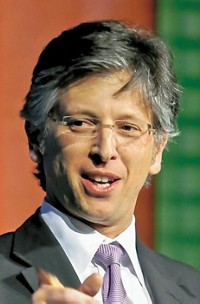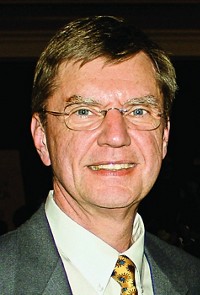Advertisement
Grab your lab coat. Let's get started
Welcome!
Welcome!
Create an account below to get 6 C&EN articles per month, receive newsletters and more - all free.
It seems this is your first time logging in online. Please enter the following information to continue.
As an ACS member you automatically get access to this site. All we need is few more details to create your reading experience.
Not you? Sign in with a different account.
Not you? Sign in with a different account.
ERROR 1
ERROR 1
ERROR 2
ERROR 2
ERROR 2
ERROR 2
ERROR 2
Password and Confirm password must match.
If you have an ACS member number, please enter it here so we can link this account to your membership. (optional)
ERROR 2
ACS values your privacy. By submitting your information, you are gaining access to C&EN and subscribing to our weekly newsletter. We use the information you provide to make your reading experience better, and we will never sell your data to third party members.
People
James Flack Norris Award in Physical Organic Chemistry
February 6, 2006
| A version of this story appeared in
Volume 84, Issue 6

Sponsored by the ACS Northeastern Section
Electron-transfer mechanisms are fundamental and ubiquitous in chemistry. They are a lot better understood because of the work of Michael R. Wasielewski, chemistry professor at Northwestern University. His combination of synthetic modeling, ultrafast laser spectroscopy, and time-resolved magnetic resonance studies has provided insights into the fundamental relationship between molecular structure and the dynamics of electron transfer between organic molecules.
Energy has been the focus of Wasielewski's research since the mid-1970s, when he first became concerned about Earth's energy capacity and storage. While many of us were sitting in gasoline lines, Wasielewski was gathering knowledge and beginning to make connections between intriguing new techniques that would enable him to see into the heart of photosynthesis.
At the photosynthetic reaction center, electron-transfer reactions occur in picoseconds, much too fast to be investigated with any of the standard techniques that were in use at that time. An additional complication is the extremely complex environment in which these reactions occur; many factors are in play, and separating the various effects was just not possible then.
Wasielewski, 56, recalls that in the mid-'70s fast laser technology provided the first opportunity to measure the rates of the primary photosynthetic reactions. At the same time, the field of biomimetics-the use of systems found in nature to study and design other systems-was also taking off. He combined these approaches in his investigations.
Cofactors of proteins involved in photosynthesis are fixed in space, so to mimic this setup, Wasielewski and his group created rigid structures similar to those involved in nature and used fast laser spectroscopy to measure the rate of electron transfer. By modifying the structures, they were able to study the effect of changes in molecular structure on the dynamics of electron transfer.
It took nearly 20 years, he says, to mimic the major aspects of these biological reactions. In the photosynthetic system, transfer takes place one electron at a time, but the nature of the electron spin dynamics complicates the ability to get at the core of how photosynthesis occurs. Wasielewski painstakingly peeled away the layers, and he's still awed that his group succeeded in getting to that core. "The properties are very subtle," he says, "and the range of possibilities to 'get it right' is very narrow."
Wasielewski has applied his systematic, what he calls "fine-grid," approach to study electron transfer in organic materials as well. Current work in his lab is focused on using organic molecules in solar cells and electronics for information processing. With an eye to using photo-driven materials to replace existing materials that require electricity to function, Wasielewski is staying true to his original muse.
Wasielewski received his education at the University of Chicago, earning three chemistry degrees: B.S. in 1971, M.S. in 1972, and Ph.D. in 1975. After completing a postdoc at Columbia University, Wasielewski returned to the Chicago area for a second postdoc, this one at Argonne National Laboratory.
In 1977, he was hired as a chemist by Argonne and he moved through the ranks to become the molecular photonics group leader in 1993, a position he held until 1999, when he left the lab. Starting in 1994, Wasielewski also was a professor in Northwestern's department of chemistry; he chaired that department from 2001 to 2004.
He has served his scientific community as a member of several advisory committees at Northwestern and Argonne; as the organizer of several conferences, including a 1994 Gordon Conference on Electron Donor-Acceptor Interactions; and as a member of the editorial board for the Journal of Photochemistry & Photobiology A: Chemistry.
Among his awards are the Inter-American Photochemical Society Research Award (2004) and the University of Chicago Award for Distinguished Performance at Argonne (1989). Wasielewski received R&D Magazine's R&D 100 Award in 1993 for work in molecular switches and in 1999 for work in photorefractivity.
He's a fellow of the American Association for the Advancement of Science, and he's also been a named lecturer at many universities and companies. Wasielewski is closing in on 300 published articles.
The award address will be presented before the Division of Organic Chemistry.—Robin Giroux




Join the conversation
Contact the reporter
Submit a Letter to the Editor for publication
Engage with us on Twitter